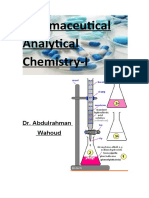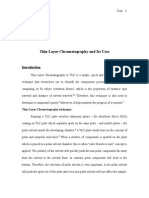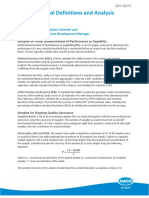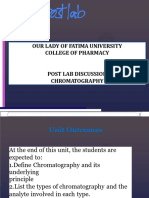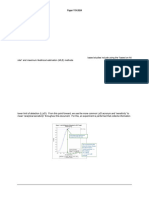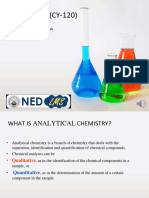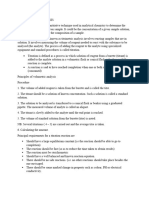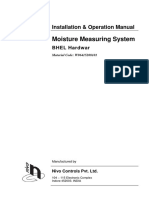Assay by Titrimetry:: What Are These Known Impurity & Unknown Impurity ?
Uploaded by
thomas_v501925Assay by Titrimetry:: What Are These Known Impurity & Unknown Impurity ?
Uploaded by
thomas_v501925Assay by Titrimetry :
Assay is nothing but content of the desired material in the given sample, assay can be calculated
on two basis, by
1) Titrations and
2) HPLC / GC
Assay by Titrations = [Titrate value of (sample - blank) x M x F x 100 x 100 ] / [Ws x (100- LOD)]
Where,
M - Molarity of Volumetric Solution,
Ws - Weight of solution,
F - Factor for drug substance,
LOD - Loss On Drying.
Assay content by HPLC :
Assay = [ At x Ws x P x (100 - LOD of std ) ] / [ As x Wt x ( 100 - LOD of sample) ],
Where,
At - Area of the sample,
As - Area of the Standard,
Ws - Weight of the standard,
Wt - Weight of the Sample,
P - Potency or Assay of standard.
RS[Related Substances] by HPLC :
There will be mostly two formulae which will be helpful for calculating RS by HPLC,
1) Calculating known impurity Level,
2) Calculating unknown impurity level.
Calculating known impurity level :
% of known impurity = ( Ri / Rs ) x 100 x RF
% of unknown impurity = ( Ri / Rs ) x 100
May be right now, you may get a doubt
What are these known impurity & unknown impurity ?
Known Impurity : The impurity which will be detected at a known RRT is called known
Impurity,
Unknown Impurity : The impurity which will be detected at a unknown RRT is called
Unknown impurity.
Another Query you may get here, & i.e.,
What is RRT ?
RRT stands for Relative Retention Time
Usually our sample for which HPLC need to be performed is pressurized into a column and while
this process under progress, some peaks will be observed at some particular times based on the
Standard solution,
and the time interval denotes the Retention time, the ratio of the sample peak Retention time to
the Standard peak Retention time is nothing but our Relative Retention Time.
Ri - Area of each impurity Peak in the chromatogram of the sample solution,
Rs - Sum of areas of Main drug and all impurity Peaks in the chromatogram of the sample
solution,
RF - Response Factor.
Total Impurities = Sum of known impurities + Sum of unknown impurities.
You may also like:
How to perform Material balance ?
Calculate LMTD correction factor
RS[Residual Solvents] by GC :
This is most used term while describing a dry product Purity & LOD, Usually RS by GC will give a
clear idea about how much of solvent is being washed away from the material during a filtration,
also it characterizes the drying efficiency,
RS by GC can be calculated as
= (At/As) x (Vol. of solvent taken x Density/10ml) x (0.1/10ml) x (Dilution of sample/Weight of
sample) x (10^6)
At= Area of the solvent in the sample - Blank
As= Area of the solvents in the standard -blank
Note: Volume of the solvents taken should be mentioned in microliters
As we are multiplying with 10 power 6 we can get the results in PPM
You might also like
- Handbook: Process Systems Engineering & ManufacturingNo ratings yetHandbook: Process Systems Engineering & Manufacturing9 pages
- Module4 - Volumetric Method of AnalysisNo ratings yetModule4 - Volumetric Method of Analysis18 pages
- 2.2.24. Absorption Spectrophotometry Infrared 20224eNo ratings yet2.2.24. Absorption Spectrophotometry Infrared 20224e3 pages
- HPTLC: Factors Influencing The TLC / HPTLC Separation and Resolution of SpotsNo ratings yetHPTLC: Factors Influencing The TLC / HPTLC Separation and Resolution of Spots8 pages
- Instrumental Analysis For Process IndustriesNo ratings yetInstrumental Analysis For Process Industries6 pages
- Separation and Purification in Chemistry Grade 9100% (2)Separation and Purification in Chemistry Grade 926 pages
- Quality Control Definitions and Analysis ProceduresNo ratings yetQuality Control Definitions and Analysis Procedures3 pages
- HPLC Topics + Analytical Method ValidationNo ratings yetHPLC Topics + Analytical Method Validation58 pages
- Some Laboratory Errors Are More Obvious Than OthersNo ratings yetSome Laboratory Errors Are More Obvious Than Others64 pages
- 5% Lambdacyhalothrin EC Analytical MethodNo ratings yet5% Lambdacyhalothrin EC Analytical Method4 pages
- LoD Estimation Methods FINAL 29Jul2024ANo ratings yetLoD Estimation Methods FINAL 29Jul2024A13 pages
- Analytical Purity Method Development and Validation by Gas Chromatography of L-Valine Methyl Ester Hydrochloride For Production of Anti-Hypertensive DrugsNo ratings yetAnalytical Purity Method Development and Validation by Gas Chromatography of L-Valine Methyl Ester Hydrochloride For Production of Anti-Hypertensive Drugs7 pages
- Report On: Swami Ramanand Teerth Marathwada UniversityNo ratings yetReport On: Swami Ramanand Teerth Marathwada University12 pages
- CHM 206 Lecture Note - Volumetric AnalysisNo ratings yetCHM 206 Lecture Note - Volumetric Analysis9 pages
- The Horwitz Ratio (HorRat) - A Useful Index of Method Performance With Respect To Precision Jaoac1095No ratings yetThe Horwitz Ratio (HorRat) - A Useful Index of Method Performance With Respect To Precision Jaoac109515 pages
- The Horwitz Ratio (HorRat) A Useful Index of Method Performance With Respect PrecisionNo ratings yetThe Horwitz Ratio (HorRat) A Useful Index of Method Performance With Respect Precision15 pages
- Modeling of Dissolution Data: Presented By: Nakat Anup Ramesh 1st SemesterNo ratings yetModeling of Dissolution Data: Presented By: Nakat Anup Ramesh 1st Semester39 pages
- Vogt Valves: Catalog and Application ManualNo ratings yetVogt Valves: Catalog and Application Manual77 pages
- A Case Study On Separation of IPA-water Mixture by Extractive Distillation Using Aspen PlusNo ratings yetA Case Study On Separation of IPA-water Mixture by Extractive Distillation Using Aspen Plus8 pages
- Isopropyl Alcohol Recovery by Heteroazeotropic Batch DistillationNo ratings yetIsopropyl Alcohol Recovery by Heteroazeotropic Batch Distillation10 pages
- Tender Doc NIT 14 Jun 2019 GLR REACTOR 2019-20No ratings yetTender Doc NIT 14 Jun 2019 GLR REACTOR 2019-2022 pages
- How To Review PV Elite Report: (Specific To Forbes Marshall)No ratings yetHow To Review PV Elite Report: (Specific To Forbes Marshall)9 pages
- Nitanium Palatal Expander: Multi-Purpose Finishing ApplianceNo ratings yetNitanium Palatal Expander: Multi-Purpose Finishing Appliance4 pages
- D and F Block Elements Previous Year QuestionsNo ratings yetD and F Block Elements Previous Year Questions3 pages
- 8 Gen Ed Final - Which Is The Best Way To WriteNo ratings yet8 Gen Ed Final - Which Is The Best Way To Write12 pages
- ChemLINE 784 Steel Application Guide Dec 2018No ratings yetChemLINE 784 Steel Application Guide Dec 201814 pages
- Sitrans FM Mag 3100 Magnetic Flow Sensor IcNo ratings yetSitrans FM Mag 3100 Magnetic Flow Sensor Ic16 pages
- 1997 Antioxidative Activity of Three Herbal Water ExtractsNo ratings yet1997 Antioxidative Activity of Three Herbal Water Extracts7 pages
- Hazard Identification Risk Assessment and Risk ControlNo ratings yetHazard Identification Risk Assessment and Risk Control4 pages









